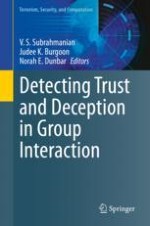2021 | OriginalPaper | Buchkapitel
10. Incremental Information Disclosure in Qualitative Financial Reporting: Differences Between Fraudulent and Non-fraudulent Companies
verfasst von : Lee Spitzley
Erschienen in: Detecting Trust and Deception in Group Interaction
Aktivieren Sie unsere intelligente Suche, um passende Fachinhalte oder Patente zu finden.
Wählen Sie Textabschnitte aus um mit Künstlicher Intelligenz passenden Patente zu finden. powered by
Markieren Sie Textabschnitte, um KI-gestützt weitere passende Inhalte zu finden. powered by
